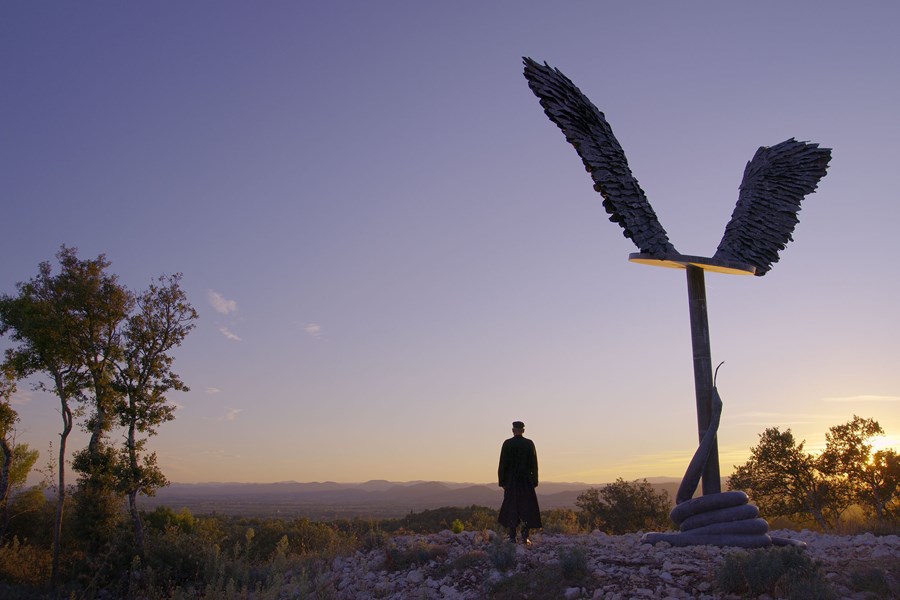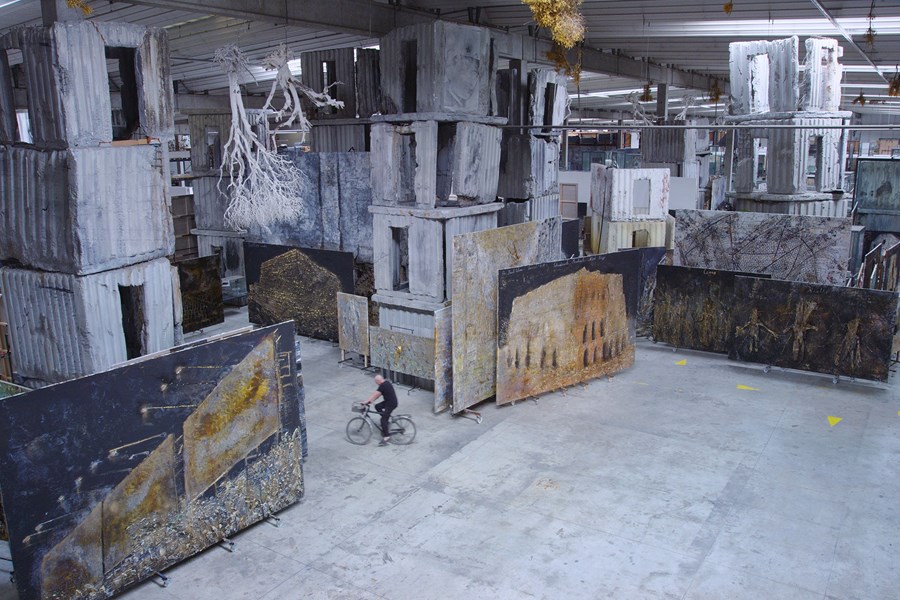In his breathtakingly beautiful documentary Anselm, Wim Wenders suggests that 3D technology can be employed to forge a new cinematic language. Bereft of the gimmickry often associated with the format, his accessible and hugely entertaining portrait of one of the contemporary art world’s most iconoclastic figures is a near-perfect melding of style and subject.

Anselm opens with morning breaking over a distant hill. Whispering voices envelop us as sunlight creeps across a valley illuminating Ra, a statue comprising Icarus-like wings, overlooking La Ribaute, on the outskirts of Barjac in southern France, where German artist Anselm Kiefer has transformed 250 acres of land into a sprawling, living art installation. For those watching the film in 3D, the shafts of sunlight penetrating the wooded landscape don’t end on the screen – the beams radiate out into the auditorium.
Like The Salt of the Earth, his 2014 portrait of acclaimed photographer Sebastião Salgado, in Anselm Wenders takes us on a journey through Kiefer’s life and career. And just as his earlier film cleverly shot many of Salgado’s images via a semi-transparent mirror, allowing us to see the photographer and his images simultaneously, Anselm employs a variety of techniques to explore the themes and influences, as well as drawing out the rich textures, of Kiefer’s work.

Anselm (2023)
Born in the immediate aftermath of the Second World War, Kiefer became a noted artist at a precociously young age. He attracted the attention of Joseph Beuys, a former Luftwaffe rear-gunner who drew on his experiences in the war to create his singular sculptures, installations and performance pieces. (He was a founder member of Fluxus, which emphasised the process of producing art.) Together, they immersed themselves in the environment movement. At the same time, Kiefer was fascinated by his country’s apparent amnesia over its recent past, producing works that either dealt directly with Nazi iconography, or reappropriated myths and cultural figures who had been embraced by the Nazis. Unsurprisingly, it made Kiefer a divisive figure in the art world. The 1980s saw his stock rise and with his newly acquired wealth, Kiefer moved into ever larger premises; from a sizeable attic studio in an old schoolhouse in Hornbach, in rural Germany, and then a factory building in nearby Buchen, to a former brick factory in the neighbouring town of Höpfingen. That latter space itself became an installation. But even that building’s scale is dwarfed against the majesty of what Kiefer achieved with his Gesamtkunstwerk in and around the disused silk factory in Barjac. Each space, and the work Kiefer produced during these times, is detailed with a sense of awe by Wenders in his film.

Anselm (2023)
Anselm is, in many ways, a summation of Wenders’ documentary work, which spans much of his film career. In the way he involves Kiefer within the narrative, often ruminating on his inspirations and themes, the film recalls Lightning Over Water, the filmmaker’s personal, affectionate 1980 paean to the – then dying – Hollywood director and maverick Nicholas Ray. And Wenders’ dramatic reconstruction of the artist’s earlier life (Kiefer as a young man is played by the artist’s son Daniel, while Wenders’ grand-nephew Anton plays him as an impressionable young boy) recalls his playful 1995 portrait of German film pioneers the Skladanowsky brothers, A Trick of Light. And the use of stereographic technology to create 3D images has played a significant role in Wenders’ work over the course of the last decade.

Until Anselm, Pina (2011) is arguably Wenders’ best-known film to be shot in 3D. But he has also employed the technology in making fiction film (Every Thing Will Be Fine, 2015; The Beautiful Days of Aranjuez, 2016) and short documentaries about a concert hall (The Berlin Philharmonic, 2014) and an iconic US artist (Two or Three Things I Know About Edward Hopper, 2020). But in every way, Anselm takes the 3D aesthetic further, arguably becoming the first film in which the form is integral in every way to what Wenders is aiming to achieve.

Anselm (2023)
Like Pina, the stereoscopic imagery in Anselm emphasises depth of field. And just as Wenders created a dialogue between Pina Bausch’s dancers and the surroundings in the German town of Wuppertal in the earlier film, here he engages in the relationship between Anselm’s work and the environment it resides in – whether it’s a huge storage facility that resembles the secret US government warehouse in the final shot of Raiders of the Lost Ark (1981) or the towers, converted warehouses and glasshouses, and subterranean world of La Ribaute. Wenders frames Kiefer’s often enormous canvasses in a way that best emphasises their scale and detail. These may be two-dimensional artworks, but the film skilfully captures their textures; the creation of some of these canvases, often forced to endure the elements, is one of the film’s highlights. But it’s in its engagement with archive footage that the film’s use of 3D proves so innovative. Wenders, working with stereographer Sebastian Kramer and cinematographer Franz Lustig, project the footage in a variety of three-dimensional environments, from a variation of the Victorian Toy Theatre to a vintage TV set and a makeshift screen stretched between two trees. In the same way, words by poet Paul Ceylan – who, along with philosopher Martin Heidegger, has had an indelible impact on Kiefer’s work – float out, beyond the screen, giving them added texture. And yet, for all the weightiness of the themes the film explores, its tone remains remarkably light, even playful, never losing sight of the more mischievous, wily aspects of Kiefer’s work and personality.

Anselm (2023)
Anselm also revels in the immensity of Kiefer’s achievement. His output is prodigious and the sheer volume of work on display in the film is staggering. But it’s also the scale of it. Nowhere more so that his city in Barjac, which is now open to the public (eschaton-foundation.com). Less an exercise in mythmaking than Kubla Khan’s (or Charles Foster Kane’s) Xanadu – or its real-world equivalent, William Randolph Hearst’s castle in California’s San Simeon – La Ribaute is the result of a bold artistic vision. Wenders’ film explores every level of the site and it’s a sight to behold.
The film closes with the day’s end and Wenders' Proustian journey through time and memory returns to the wings of Ra. Anselm Kiefer stands next to it for a moment, before disappearing, suggesting that this art, like the landscape that surrounds it, will remain long after we’re gone.
ANSELM IS IN CURZON CINEMAS FROM 1 DECEMBER




